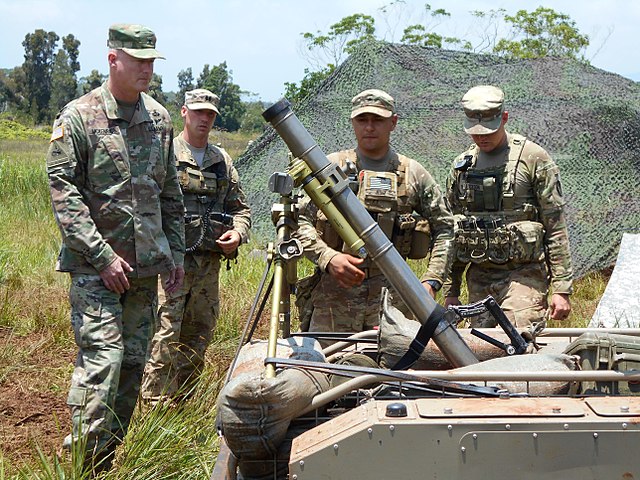By Kimberly Bratic – https://www.dvidshub.net/image/2826425/tardec-tests-manned-unmanned-teaming-capabilities-pacific-initiative, Public Domain, https://commons.wikimedia.org/w/index.php?curid=53626896
The race to create a coronavirus vaccine was a contest for not just technological bragging rights, but geopolitical superiority. As the most recent National Defense Strategy and National Security Strategy emphasize, the United States must “out-innovate” competitors, like China, if it hopes to maintain its security and prosperity.
But America doesn’t simply need to innovate more; it needs to innovate how it innovates. It must reform how it approaches the critical task of invention, including by better utilizing its intellectual capital and that of vital strategic partners.
American infrastructure for defense research and development (R&D) burgeoned during the early Cold War years and aided the country’s triumph over the Soviet Union’s planned economy. However, US commitment to R&D has since adopted a worrying declining trajectory.
Currently, the processes in place for facilitating innovation, particularly within the defense sector, are rife with bureaucratic roadblocks and ineffective and narrow-minded approaches.
Misaligned Incentive Structure
Firstly, the Pentagon’s incentive structure for pursuing emerging technologies — and in turn, collaborative ventures with key allies — is misaligned.
Since the Pentagon appropriations ultimately come from taxpayer dollars, the department and armed services understandably are averse to tackling riskier technology projects that might result in Congressional questioning over perceived wasted resources.
However, any game-changing tech breakthroughs necessitate accepting a certain level of risk. To reflect this fact, the budgeting process might benefit from fewer punishing mechanisms from Congress — such as reduced or zeroed budget authorizations and appropriations — and greater tolerance for unsuccessful ventures if the Pentagon can demonstrate the worthiness of the initial investment.
Capitol Hill’s annual budget cycle isn’t wholly to blame, though. Excessive caution within the Pentagon’s R&D and acquisition apparatus mitigates fears of zeroed budgets, canceled programs, and career derailment. As a result, innovation suffers.
Taking a page out of the Silicon Valley mantra, the message from the Pentagon’s top leadership down to the defense program managers must be that innovative risk-taking. This is a necessary element in achieving transformational (as opposed to incremental) progress.
This has begun with the Pentagon’s Defense Innovation Unit and the army’s nascent Futures Command that are adapting agile commercial-sector practices to the sclerotic defense research and acquisition systems, but the process must now accelerate to make up for the lost time.
Collaboration
Furthermore, the bureaucratic drag impacts America’s ability to collaborate with like-minded, technologically advanced allies. For instance, Washington should be capitalizing on its extensive partnership with technological giants like Israel, and it simply is not.
Israel is the quintessential “start-up” nation with one of the world’s highest R&D expenditure rates, and despite its small size, it boasts the greatest number of start-ups per capita. Unsurprisingly, according to the 2019 Global Innovation Index, Israel placed first in the number of researchers per capita and research talent in business enterprises.
Israel and its adversaries make the Middle East an effective laboratory for testing innovative technologies in real-world settings, a fact that has made its security sector exceptionally adept at developing new defense capabilities relatively quickly and with limited resources.
Yet, despite the two countries being prime candidates for R&D collaboration, Washington’s export controls regime restricts such efforts. While not a full impediment, Israel’s lack of Tier 1 Strategic Trade Authorization (STA1) status often slows down the exchange of information and technology immeasurably.
Though STA1 typically is dependent upon a country acceding to all four multilateral export control regimes, certain exceptions have been made. This is the case with India, whose increasing role as a US defense partner and commitment to improving its export controls regime all factored into its upgraded status. It may be worth considering whether Israel is eligible for a similar exception.
Umbrella Body
There are other mechanisms Congress might consider pursuing as well, including establishing a permanent umbrella body to oversee R&D collaboration between Washington, Jerusalem, and perhaps interested Gulf States. The body could identify joint capability gaps, minimize duplication, and direct resources based on shared policy priorities.
Congress might also contemplate authorizing and funding the creation of a joint research unit that consists of engineers and officers from both the US and Israel who commit to long-term research projects exclusively in the defense space.
Any such project would require a defined budget; a concrete, measurable mission; and a reasonable timeline of five to ten years.
‘Not Invented Here’ Syndrome
All of these suggestions aside, any international collaborative efforts will require the US defense sector to engage in a real reckoning with its own “Not Invented Here” syndrome, an attitude premised upon rejecting innovations just because they were not developed domestically.
Even if not overt, such behaviors directly inhibit a nation’s ability to adopt potentially powerful technologies that have been produced abroad.
Staving off Chinese hegemony in the technology space will require creative thinking and a willingness on the part of the United States to restructure how it innovates.
The intellectual capital is present, both here and among like-minded allies. It now is up to the United States to make the most of such resources.
Erielle Davidson is a Senior Policy Analyst at the Jewish Institute for National Security of America’s (JINSA) Gemunder Center for Defense & Strategy.
Charles Perkins is Director for US-Israel Security Policy at JINSA.
Originally published in The Defense Post

